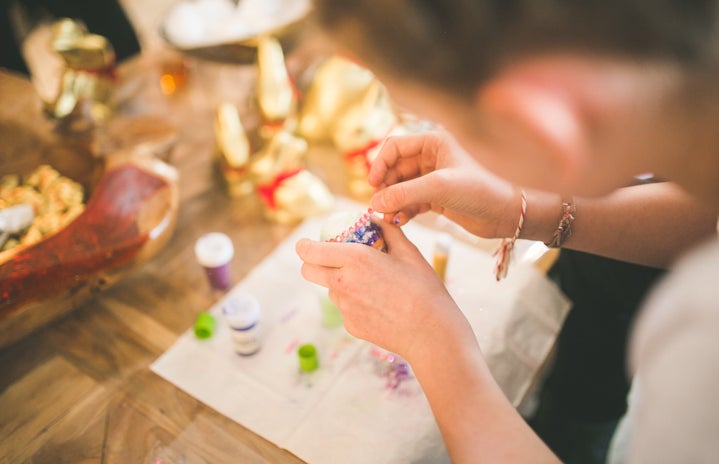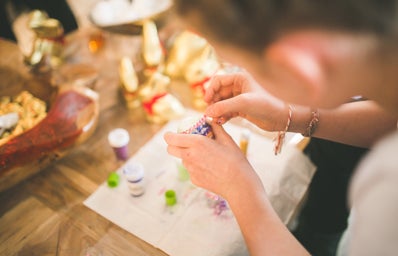Artists have taken the craft of embroidery far beyond antiquated homec requirements and homey greetings. Starter kits like this and this truly give you a lot of thread that you won’t run out of anytime soon. Hoops are cheap, and I started embroidering on a sliced-up $3 t-shirt. Stitching a special something is a rad way to create a cottage-y atmosphere in your space. You can weave some personality into your attire, or do a little surgery on a bothersome rip. Embroidery’s also great for gift-giving – nothing quite says “I love you” like stabbing some fabric by hand a thousand times.
So now that you’re sold, you’ve scrolled through a few embroidery instas (way too many good ones to link), you’re probably finding a lot of wild things beyond straight forward backstitching. Here are a few tips and tricks I’ve learned through my hoops and errors.
- METALLIC FLOSS ??!
-
This exists!! It’s generally a tad more expensive than your typical skein, but how cool is that?? Unfortunately for us, it is the absolute worst to work with. You must really love someone if you’re willing to use metallic floss for them, and that’s not just because of the slightly augmented price. Its shiny sister, satin, is no better.
The worst thing about metallic floss has to be its tendency to fray. It’s horrifying to thread for that reason, and it also has a particular affinity for slithering out of needles. You’ll absolutely need to lick that end and make a mental offering in order to thread it. Once you’ve threaded it, keep the tail coming out of the eye of your needle absurdly long to mitigate risk of escape. Same with the knot at the end – keep the tail absurdly long. That knot will try the same nonsense.
I could only muster stitching a few words before surrendering to pure metallic floss, but I’ve found it manageable in moderation. Cut some thread, however long, and then you can split the floss. Lessening the thickness makes the thread more malleable and less unwieldy. Once you’ve split it, you can also combine it with more agreeable colors.
- Color Combination
-
Pick out a few colors and cut some pieces of equal/near equal length. Split the floss. Align the strands, knot the end together, thread the other end, and stitch as normal! Using this method, I stitched bits of a Henry David Thoreau quote on a t-shirt for my friend’s birthday.
- French Knots
-
Super cute, versatile for making flowers, curls, seafoam… really anything! These people have explained the stitch far better than I could. I’m honestly not the best at french knots, but even faulty knots can be saved with a bit of improvisation.
- Yarn??
-
I’ve found yarn super fun to work with to add some texture to your piece. Here, I made some fun bubbling brew with some scrap yarn and tinsel. All I really did was scrunch up the yarn how I wanted it and stitch around tightly and semi-strategically with a similarly-colored thread to hold it in place.
I couldn’t top off this section without dropping a link to an absolute pro who often uses yarn in her landscapes. - Hair?
-
I saw work like this and this and immediately wanted to know how they’d managed to have 3D hair. What I’ve done is a bit similar to what I’ve done with yarn. First, I cut some floss to about double the length I’d like, separated the individual strands, and regrouped them loosely. This is a little chunk of hair. Then, wherever I’d like this bunch of hair to go, I set up for a simple stitch. Then, line up the chunk of hair so that your prospective stitch marks the halfway point in your chunk. Make a tight stitch, trapping the little chunk, and then fold over the top half of the chunk. Repeat as needed.
Generally, I’ll have the whole design drawn out on the fabric beforehand. If I’m doing a full back of head design, I’ll start near the neck, and consciously cut longer thread as I move up to the top of the head. If it’s not a full-head sort of design, it’s a bit easier to wing it and be less strategic.
For more complex hair textures, I’ve found that you can wet thread and wrap it tightly around a needle. Once the thread dries, it should be curly, though you shouldn’t stretch it out again or test its limits. You can use the same procedure to stitch down curly hair, though you’ve got to be mindful not to upset the texture. (Example in the next picture!)
You can also follow Youtube creator Pumora’s tutorials, linked here. I personally haven’t used these methods, but it works incredibly for her pieces.
- Incorporate Tiny Objects!
-
Don’t be afraid to stitch in a few more 3D elements! Here, I sewed down two needles that were uselessly tiny. Now they’re living a second life as knitting needles in this pop-out piece.
- Watercolor
-
Don’t plan on washing your hand-crafted wall-hangings? Me neither! Watercolor is great for adding a little background color to your art. For cotton, I’ve found that wetting the fabric before painting makes your brush strokes smoother, and allows the color to really stick in there. However, you shouldn’t use watercolor on garments – it’ll just wash out. The sharpie and rubbing alcohol method (provided you give it a good saltwater soak afterwards) is useful, albeit less predictable, for dying clothes.
- Be Organized!
-
Grandma’s cookie tins are great for taking a project on the go, but over time, your embroidery floss can quickly turn into a tangled hellscape. As your collection grows, I would highly recommend getting something like this to organize all your thread. It’ll take a while to set it up, but wrapping the thread around the bobbins can be quite relaxing, and it’s certainly worth it in the end.
If I were to recommend all of the embroidery accounts and hashtags that I believe deserve recognition, this article would grow to be insufferably long. If you check out the following list on my embroidery account, you could definitely find some people who know their way around a needle. My last tip is to get out and explore yourself — you never know who can spark inspiration or what you can invent!
Happy Stitching!



